|
Defects
|
Probable causes for the defect
|
Design for Maintainability (DfM) Guidelines
|
| Scale on condenser: low chiller efficiency |
- Open loop design of condenser water.
- Inadequate maintenance and cleaning of condenser tubes or cooling tower.
|
Design
Construction
Maintenance
|
|
Chiller frequently unloading (stop-start); Compressor not starting
Corroded parts of condenser – face plate, tubes.
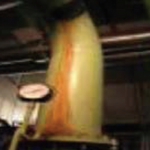 Rust stain 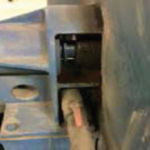 Leaking condenser pipes |
- Tubing material is not resistant to corrosion / pitting.
- Paint protection lost during careless installation or harsh maintenance.
- Harsh cleaning (hard brush, strong acid etc) cause thinning of copper tube walls, leading to of pitting or formicary corrosion.
- Poor workmanship at joints. Should be tested.
- Harsh cleaning method makes pipe thin. Excessively thinned pipes should be plugged or replaced.
|
Design
- Conform to the minimum requirements for air- conditioning equipment efficiency as per SS 530. (See also ANSI/ASHRAE/IES Standard 90.1).
- Specify proper placement for installation of temperature sensors/probes to capture realistic average temperatures of spaces in accordance with SS 591.
- Conform to the safety and environmental requirements for refrigeration systems (ISO 5149-1/Amd1).
Construction
- For applications with high dynamic load conditions of a facility, install and commission chillers with variable speed drive (VSD) compressors. (SS 652: F.6.1.1.1)
- Ensure that schematics and maintenance regime of refrigerant leak detection system are handed over to maintenance personnel upon completion. (SS 652: F.6.1.1.2)
- Ensure sufficient loading of the chiller, avoid mismatch and operations under the capacity of less than 25% of its handling capacity.
- Avoid scaling in condenser tubes causing higher condenser pressure.
- Avoid excessive amounts of non-condensable present in refrigerants either due to leakage in the evaporator or irregular purging.
Maintenance
- Set up appropriate cut-in and cut-out temperatures in chiller to avoid frequent unloading (SS 652: F.11.1.1.1) .
- Inspect evaporator tubes for excessive oil, dirt or frost; check operating condition of expansion valve; check condenser tubes for air, dirt, scale, and sludge, and clean/purge if necessary.
- Check condenser water supply and cooling tower efficiency. Inspect overload relay, and the condition of high pressure and low pressure cut-outs. (SS 652: F.11.1.1.2).
- Conduct monthly inspection on refrigerant level to avoid low pressure cut-outs of chiller in accordance ANSI/ASHRAE/ ACCA Standard 180. (SS 652: F.11.1.1.3) and compare with the standard list of normal acceptable operating range to ensure the best possible performance and efficiency of a chiller.
|
Insufficient/slow cooling
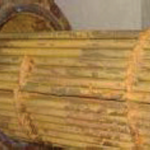 Scale in condenser pipes Condensation on chilled water pipes
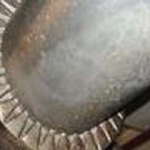 No insulation for chilled water pipe Refrigerant leakage
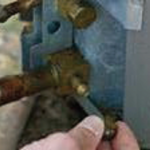
|
- Pipe surface become cold if insulation is inadequate.
- Insulation is damaged during careless maintenance of the equipments.
- For positively pressured chillers, refrigerant leaks through joints (at gasket, piping, monitoring socket etc), which may be opened for maintenance and later not tightened.
- No checking for system leakage and remedial measures taken.
|
Design
- Design chiller plants according to the required cooling demand, with provisions for future expansions as per SS 553 and in compliance with the requirements of SS 554. (See also AS 1668.2, ISO 16814).
- Comply with air conditioning plant optimisation strategies (e.g. high-efficiency chillers, aggressive condenser water reset, medium temperature chilled water loop, chilled water VFD pumping, etc.) as per SS 564-1.
- Use refrigerants with zero ozone depleting potential (ODP) or global warming potential (GWP) of less than 100 [1].
- Recommend installation of leak detection system in critical areas of plant rooms.
- Ensure minimum environmental standards in accordance with the Code for Environmental Sustainability of Buildings. For industrial facilities, ensure compliance with NEA’s Minimum Energy Efficiency Standards (MEES).
Construction
- Conduct proper commissioning of chiller plant and set reasonable points.
- Perform post installation monitoring of the installed instrument’s performance through the BMS (building automation system) or EMS (energy measurement system). (SS 652: F.6.1.2.1).
- Document as-built drawings (including concealed services) for building user phase.
- Prepare and handover maintenance checklists for service and repair of each instrument during commissioning. Refer to measures for recommended monitoring procedures for chiller efficiency as per SS 591 or equivalent. (SS 652: F.6.1.2.2).
- Ensure sufficient loading of the chiller, avoid mismatch of capacity and operations under the capacity of less than 25% of its handling capacity,
Maintenance
- Inspect temperature controllers and thermostatic control valve for any malfunctions and then reset. (SS 652: F.11.1.2.1).
- Perform routine inspection of condenser pipes and clean and conduct servicing (de-scaling) if/when necessary. (SS 652: F.11.1.2.2).
- Routinely inspect insulation for any damaged/worn-out layers. Daily logging of chiller system to ensure system operates at optimal conditions. Any deviation from the intended chiller operation or alarms need to be attended to promptly. (SS 652: F.11.1.2.3)
- Perform annual shutdown or overhauling as per manufacture’s guidelines (ANSI/ASHRAE/ACCA Standard 180). (SS 652: F.11.1.2.4).
|
| Refrigerant contamination |
- Leakages of condenser tubes induce moisture to refrigerant.
- Incondensable gas (air, moisture) diffuse, leak or evaporate into chiller through joints, cracks and gaps. Requires purging.
- Mixing of fines from metallic moving parts of compressor motor or of lubricant. Selection of refrigerant is improper.
- Excessive oil added to refrigerant by faulty pump or its valve. As an indicator, oil level should be checked from time to time.
|
Design
Construction
Maintenance
|
| Surging of the chiller |
- Insufficient loading of the chiller, mismatch of capacity, operation under capacity of less than 25% its handling capacity.
- Scaling in condenser tubes causing higher condenser pressure. Ch1
- Excessive amount of non-condensable present in refrigerant either due to leakage in evaporator or irregular purging.
|
|
| Excessive noise & vibration |
- Inadequate or worn out spring isolators.
- Inadequate acoustical insulation in the machine room.
- Mechanical failure of parts – should be tested from time to time.
- Compressor worn. Accelerated aging occurs if the chiller is constantly running or frequent start-stop.
|
Design
Construction
Maintenance
|
|
Chilled water pipe and condenser pipe leakage and condensation
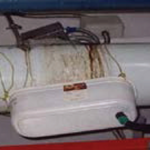 Leaking of motor valve |
- Damaged mechanical seal of valve from wear and tear.
- Not fitted properly after servicing, usually if access is difficult.
- Poor workmanship at the socket joint during installation.
|
Design
- Conform to the pump system’s design’s calculation and required outputs as per ISO 13612-1. (SS 652: F.1.2.1)
- Specify the provision of flow meters for chilled/condenser water loops. (SS 652: F1.2.3)
- Specify the use of unplasticised PVC pipes for cold water services/industrial use as per SS 141 (see also ISO 1452-1).
Construction
- Ensure proper workmanship during pipe installation and testing, especially at joints. (SS 652: F.6.1.3.1)
- Perform proper insulation of chilled water pipes to avoid condensation. (SS 652: F.6.1.3.2)
- Install primary-only variable flow chilled water pumping systems in accordance with SS 564-1 or equivalent (SS 652: F.6.1.3.3).
Maintenance
- Conduct quarterly check for pitting noise in pumps. Avoid harsh cleaning methods that may damage pipes or cause the thinning of pipes. (SS 652: F.11.1.3.1)
- Prepare maintenance checklist for flow meters (ultrasonic and full-bore magnetic in-line types) in accordance with SS 591, ISO 12242 or equivalent. (SS 652: F.11.1.3.2).
- Check the integrity of the insulation to prevent condensation.
|
References
[1] ASHRAE (2016). ASHRAE Standard 15 — Safety Standard for Refrigeration Systems
and Designation and Classification of Refrigerants. USA: ASHRAE.
Normative References/Standards Referred to for Chiller Plant
- ANSI/ASHRAE/IES Standard 90.1 — Energy Standard for Buildings Except Low-Rise Residential Buildings
- ANSI/ASHRAE/ACCA Standard 180 — Standard practice for inspection and maintenance of commercial building HVAC systems
- AS 1668.2 — The use of ventilation and airconditioning in buildings — Mechanical ventilation in buildings
- ISO 12242 — Measurement of fluid flow in closed conduits — Ultrasonic transittime meters for liquid
- ISO 13612-1 — Heating and cooling systems in buildings — Method for calculation of the system performance and system design for heat pump systems — Part 1: Design and dimensioning.
- ISO 1452-1 — Plastics piping systems for water supply and for buried and aboveground drainage and sewerage under pressure — Unplasticized poly(vinyl chloride) (PVCU)
— Part 1: General
- ISO 16814: — Building environment design — Indoor air quality — Methods of expressing the quality of indoor air for human occupancy
- ISO 5149-1/Amd 1 — Refrigerating systems and heat pumps — Safety and environmental requirements — Part 1: Definitions, classification and selection criteria. AMENDMENT 1: Correction of QLAV, QLMV.
- SS 141 — Specification for unplasticised PVC pipe for cold water services and industrial uses
- SS 530 — Code of practice for energy efficiency standard for building services and Equipment
- SS 553 — Code of practice for air-conditioning and mechanical ventilation in Buildings
- SS 554 — Code of practice for indoor air quality for air-conditioned buildings
- SS 564-1 — Green data centres — Part 1: Energy and environmental management systems
- SS 591 — Code of practice for long term measurement of central chilled water system energy efficiency.





